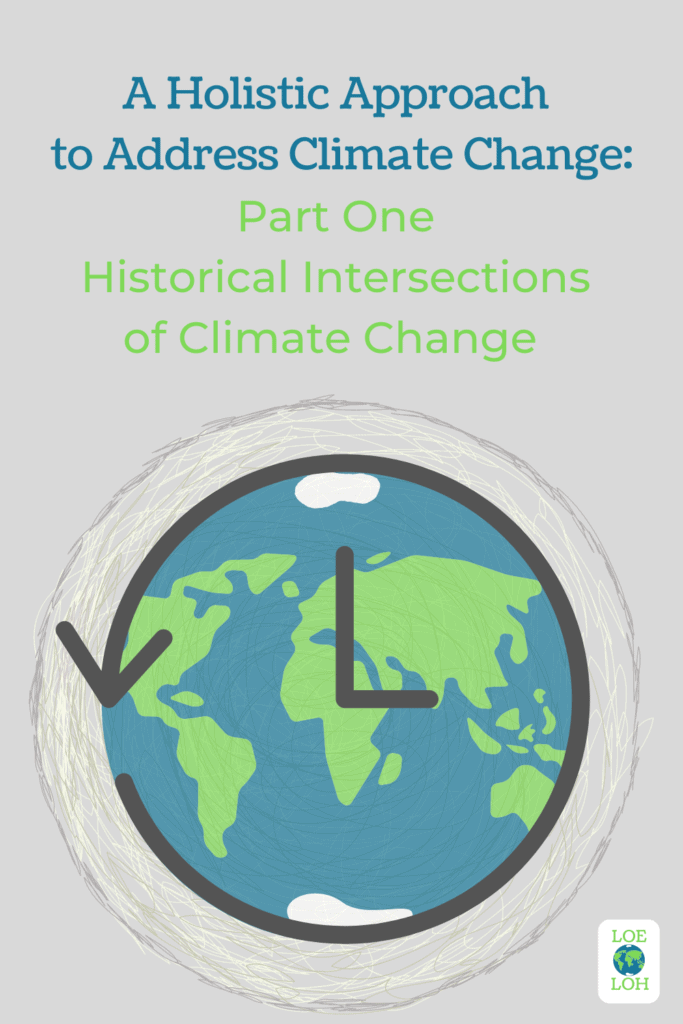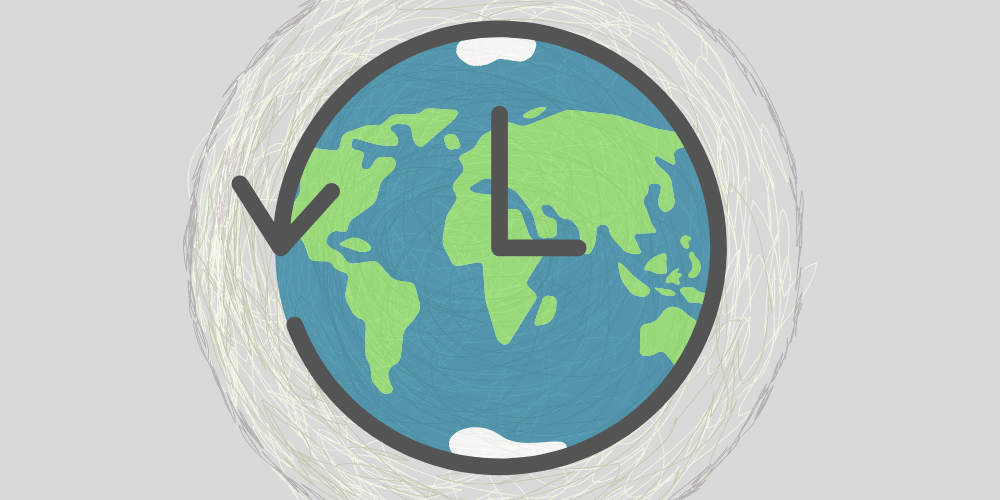Since starting Loeloh, I’ve learned that there is much more to climate change than reducing our greenhouse gas emissions. We need to have a holistic approach to effectively address climate change and all it encompasses.
This is because climate change is only one outcome of the global economy that over centuries has decimated Earth’s natural systems while exploiting people in its making and growth. Climate change is intertwined not only to our emissions but also to today’s social injustices and our economy. To effectively address climate change we need to have a holistic approach that takes on the historical intersections of our economy, social injustices and human caused ecological imbalances.
Here in part one of this series we will review those historical intersections of climate change and social injustices. As well as their connections to the economy of European colonization. For part two we will explore a new way to evaluate the economy that incorporates both the needs of Earth’s systems AND the social needs of the population. In part three, we’ll review examples of holistic approaches to address the intersections of climate change and social justice. In addition, what you can do to be apart of the holistic approach to address climate change.
A Holistic Approach to Effectively Address Climate Change
The Historical Intersections of Our Economy, Social Injustices, Climate Change, and practically everything else.
It is estimated that in the 16th century, the first steps of human caused climate change were taken through the global colonization by the Europeans. Through the colonization of Africa, Asia, Australia, and the Americas, the Europeans built an extractive economy. Doing so generated wealth primarily for Europeans at the expense of colonized Indigenous peoples and their land. This laid the groundwork for continued unequal economic gains, social injustices, and ecological imbalances we experience today.
European colonizers reasoned that they were “superior” to Indigenous peoples. They also thought they were religiously and legally responsible to take away the land and convert the religious practices of Indigenous people. Fueled by these ideas, European colonizers used “physical and psychological force” to destroy Indigenous societies, establish racialized chattel slavery of Africans, and damage gender roles, all while destroying the native ecology.
Destruction of Indigenous Societies and Their Land
Around the world, European colonizers came across a variety of different Indigenous civilizations ranging from subsistence groups to entire kingdoms. Often Indigenous cultures, were (and still are) intricately connected to their natural surroundings. Their Indigenous knowledge and traditions were passed down from generation to generation.
However, during European colonization, large groups of Indigenous peoples were killed either violently or from the diseases brought by Europeans. While other Indigenous communities were forced off their land or forced to assimilate to European practices of agriculture, education, and religion. Consequently, this decimated Indigenous cultures and the lands they lived on.
By forcing Indigenous groups off their land the Europeans ignored the Indigenous’ relationship to their home. The Europeans also changed the agricultural system and how Indigenous people were able to obtain food. This is best illustrated by the following quote, “What was grown became disconnected from what was eaten, and for the first time in history, money determined what people ate and if they ate.”
The Europeans changed how the land was used, shifting ecological balances by growing single crops (monoculture) and overharvesting. These preceptors of industrial agriculture, disrupted natural cycles of the land and water and destroyed the native biodiversity. The European system of agriculture damaged ecosystems while it benefited the extractive economy of Europe and European colonists, through import of raw materials from colonies to Europe. The cash crops of cotton, tobacco, and sugar, fed the European economy.
As the European economy grew from agricultural imports from their colonies, so did the need for more labor on the plantations. Indigenous peoples were sometimes forced to provide this labor. However, much of the increased demand of manual labor came from one of the most egregious, violent, and psychological tactics of the European colonists; chattel slavery of Africans.
Established Chattel Slavery of Africans, a Racialized Institution
We’ve mentioned that European colonists believed that they were “superior” compared to the numerous Indigenous peoples they encountered. This belief is at the center of chattel slavery, in which enslaved Africans and their descendants were seen as property rather than human beings as a source of free labor. To be clear, there was slavery in Africa and all around the world before the trans-Atlantic Slave Trade. However, the Europeans expanded and exploited enslavement of Africans into a “racialized institution,” of White Europeans enslaving Black Africans.
Chattel Slavery, Land, and Wealth
Dr. Molefi Kete Asante, an expert in African American History, described the conditions and practice of chattel slavery of Africans as follows. “Enslaved Africans were people who had neither rights nor freedom of movement, and were not paid for their labour because they were seen as ‘things’. Aside from food and shelter the enslaver had no responsibility to the enslaved, but would allow the enslaved no space to have responsibility for himself or herself…..An African who was enslaved had no personal or private rights and was expressly the property of another person to be held, used, or abused as the owner saw fit.”
About 12.5 million Africans were forced into the trans-Atlantic slave trade. These African men, women, and children were coerced to provide the labor under violent treatment by European colonists. The labor African slaves provided grew the wealth of Europeans and their North American counterparts, on vast plantations that demised the land. For example the export of U.S. cotton, from 1801 to 1835, went from 100,000 bales to over one million bales.
Aaron Joslin a PhD student explained, “the ecological consequences of cotton farming and the slave labor that enabled it…were enormous and inhibit agriculture in the {United States} South to this day.” Before the Civil War, there were more “millionaires per capita in the Mississippi River valley than anywhere in the nation”
The racialized inhumane enslavement of Africans by Europeans was a result of the Europeans believing they were “superior” to Africans and needing more labor for their expanding plantations. These plantations of monoculture cash crops expanded the economy and wealth of Europeans colonists. Which cost the lives of Africans and devastated the lands they were on.
Damaged Gender Roles
Prior to European colonization, there are examples of various roles and ways genders were acknowledged throughout the world. For instance, in Yoruba society (located in today’s Nigeria, Togo, and Benin), there was not a distinguished dichotomy of male and female; rather a spectrum of gender. So in Yoruba, people were not excluded in different sectors of society nor were they ranked differently based on their gender. In some Indigenous cultures roles were designated for people based on their personal characteristics rather than their biological traits. Additionally, in other Indigenous groups, women were ranked in leadership roles with men.
The belief Europeans held that they were “superior” to the Indigenous peoples. This included Europeans’ perception of how different Indigenous societies viewed genders. Per Dr. Sally Kitch, an expert in women studies, “The Europeans thought that cultures in which men and women weren’t that different in terms of their behavior or appearance were uncivilized.” And so the European colonists inflicted their ideas of binary genders and roles on the people they colonized.
By disenfranchising gender systems in colonized places it gave the Europeans an advantage to further their economic reach. For example the Europeans allowed for Yoruba men to maintain their roles but not women. Instead Yoruba women lost rights including ownership of land, an important source of wealth. Additionally, Indigenous, and African women were placed at the intersection of both gender and racial hierarchies, experiencing additive effects. Both were often victims of sexual violence by European colonists. While enslaved African women were also forced to provide physical labor and care for European children.
Previous gender social structures in colonized places were upended by European colonists. This destroyed the rights of women and those on the gender spectrum. Furthering the European colonists power, economic gain, and depletion of land resources.
Connecting the Historical Intersections of Climate Change to Today
Through colonization, the Europeans constructed a global extractive economy where wealth was spread to few at the cost of so many peoples lives, cultures, and lands. As the European economy spread around the world so did their racist beliefs, concepts of gender, and exploitative extractive practices. We continue to experience and witness the consequences of colonization today, as shown in these examples.
- Racism
- Anti-Blackness
- Colorism
- Devaluing of Black people, Indigenous people, and People of Color (i.e. racial inequalities, sacrifice zones, disparity of climate effects)
- Gender Inequalities
- Anti-LGBTQ hate
- White Supremacy
- Police Brutality
These social injustices are deeply intertwined with human caused ecological imbalances including pollution, biodiversity loss, and climate change. They are all interconnected to the colonial past of our global extractive economy. Because of this, reducing greenhouse gas emissions as the only answer to address climate change is not enough.
We cannot continue to grow an economy that perpetuates social injustices and the devastation of our home. This model has been playing out for centuries and we know it does not work. Thus to best address climate change is a holistic approach. Where the goals of our economy and society are centered around both the needs of people and our planet. In part two of this series we’ll look at an economic theory that connects us all with our shared home.

Image credit: Circle Doodle, By jomaplaon, History Icon, By: cuongkieuthikim, World Map on Globe By DAPA images


Yay! I am so happy! Now I know how to help the earth!
Hi N! Wonderful to hear! Thank you for sharing your helping hand. It is going to take all of us!